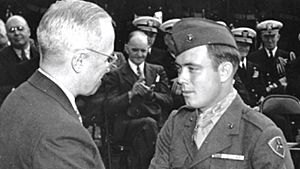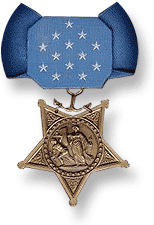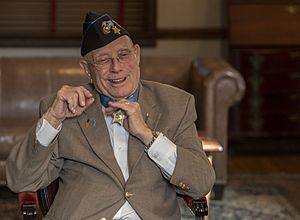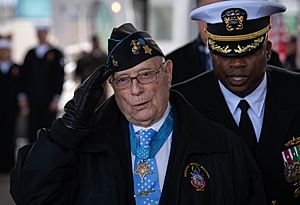Hershel W. Williams facts for kids
Quick facts for kids
Hershel W. Williams
|
|
|---|---|
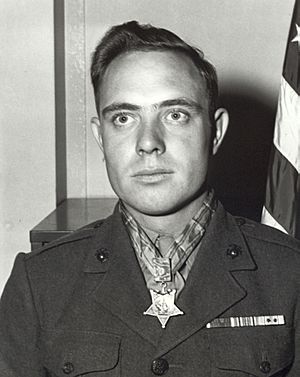
Williams in uniform, 1945
|
|
| Birth name | Hershel Woodrow Williams |
| Nickname(s) | "Woody" |
| Born | October 2, 1923 Quiet Dell, Marion County, West Virginia, U.S. |
| Died | June 29, 2022 (aged 98) Huntington, West Virginia, U.S. |
| Allegiance | United States |
| Branch | Marine Corps Reserve |
| Years of service | 1943–1945 1948–1949 1954–1969 |
| Rank | Chief Warrant Officer 4 |
| Unit | 1st Battalion, 21st Marine Regiment, 3rd Marine Division |
| Battles | |
| Awards | Medal of Honor Purple Heart |
| Other work | Veterans Administration Hershel Woody Williams Medal of Honor Foundation |
Hershel Woodrow Williams (born October 2, 1923 – died June 29, 2022) was an American hero who served in the United States Marine Corps Reserve. He was also known by his nickname, "Woody".
Woody Williams received the highest award for bravery in the United States military, called the Medal of Honor. He earned this award for his amazing courage during the Battle of Iwo Jima in World War II. When he passed away, Woody Williams was the very last person alive who had received the Medal of Honor from World War II.
Contents
Early Life and Growing Up
Hershel Williams was born in Quiet Dell, West Virginia, on October 2, 1923. He was the youngest of eleven children and grew up on a dairy farm. When he was born, he was very tiny, weighing only 3.5 pounds, and doctors weren't sure he would survive. His mother named him after the doctor who helped him.
By the time he was 11, his father had passed away. Woody worked many different jobs, like driving trucks and taxis. When the Japanese attacked Pearl Harbor in 1941, which started America's involvement in World War II, Woody was working in Montana.
Joining the Marines
Woody Williams wanted to join the Marines because he loved their fancy blue uniforms. He thought the Army's brown uniform was "the ugliest thing." He didn't know much about the Marines, but he knew he wanted to wear those dress blues!
In 1942, he tried to join, but he was too short at 5 feet 6 inches. Luckily, the rules changed in early 1943, and he was able to join the United States Marine Corps Reserve on May 26, 1943.
He went through basic training in California. After that, he learned how to be a demolition man and how to use a flamethrower. He said the training taught him how the flamethrower worked, but they had to learn how to use it in battle by themselves.
In 1944, he joined the 3rd Marine Division and fought against the Japanese in the Battle of Guam.
Heroic Actions at Iwo Jima
Woody Williams' most famous actions happened during the Battle of Iwo Jima in February 1945. This was a very tough battle. On February 21, 1945, he landed on the beach with his unit.
Two days later, on February 23, his company was stuck. American tanks couldn't get through because of strong Japanese bunkers called "pillboxes." These pillboxes were made of concrete and had machine guns firing from them.
Woody, who was a corporal at the time, bravely volunteered to go forward alone. He was only covered by four other riflemen. For four hours, under heavy enemy fire, he kept going back and forth to get more flamethrowers and demolition charges. He would then attack the enemy positions one by one.
- Once, he put the nozzle of his flamethrower into a pillbox opening and fired, killing all the soldiers inside.
- Another time, he noticed smoke coming from a Japanese bunker. He got close enough to put his flamethrower nozzle through the air vent, defeating the enemy inside.
- Enemy soldiers even tried to stop him with bayonets, but he used his flamethrower to fight them off.
Woody later said that much of this intense fighting was "just a blank" in his memory.
These brave actions happened on the same day that two American flags were famously raised on Mount Suribachi, which Woody could see from about a thousand yards away. He continued fighting through the entire five-week battle. On March 6, he was wounded in the leg and received the Purple Heart award.
In September 1945, he returned to the United States. On October 5, 1945, President Harry S. Truman personally presented Woody Williams with the Medal of Honor at the White House. He was honorably discharged from the Marine Corps in November 1945.
After the War
After World War II, Woody Williams worked as a counselor for veterans at the United States Department of Veterans Affairs. He helped many former soldiers. He worked there for 33 years.
For a long time, he struggled with the stress of combat. But in 1962, he found peace through his faith. He later became a chaplain for the Congressional Medal of Honor Society for 35 years.
He was a member of the Sons of the American Revolution and the Marine Corps League. His Medal of Honor is now on display at the Pritzker Military Museum & Library in Chicago.
Awards and Honors
Woody Williams received many military awards and honors for his service:
- Medal of Honor
- Purple Heart
- Navy Presidential Unit Citation
- Navy Unit Commendation
- Selected Marine Corps Reserve Medal
- Vietnam Civilian Service Award
- American Campaign Medal
- Asiatic-Pacific Campaign Medal
- World War II Victory Medal
- National Defense Service Medal
- West Virginia Distinguished Service Medal
His Medal of Honor citation describes his actions: It says that Corporal Williams showed amazing courage and bravery. He went forward alone to destroy enemy machine gun positions on Iwo Jima. He fought for four hours under heavy fire, repeatedly returning to get more flamethrowers. He destroyed many enemy positions, even putting his flamethrower nozzle into a pillbox vent to kill the enemy inside. He also fought off enemy soldiers who tried to stop him with bayonets. His incredible determination helped his company reach its goal.
Later Honors
Woody Williams received many honors throughout his life:
- In 1965, he received West Virginia's Distinguished Service Medal.
- In 1967, he was given the Civilian Vietnam Service Award.
- In 1999, he was added to the City of Huntington Foundation's "Wall of Fame."
- He received the 2014 Founder's Award from the Pritzker Military Museum & Library.
- The West Virginia state legislature honored him in their Hall of Fame.
- A National Guard facility in his hometown of Fairmont, West Virginia, is named the Hershel "Woody" Williams Armed Forces Reserve Center. It's the only National Guard facility named after a Marine.
In 2010, the Hershel Woody Williams Congressional Medal of Honor Education Foundation was started. This group helps "Gold Star Families," who are families who have lost a loved one serving their country. Woody Williams was on the board of this foundation.
In 2018, Woody Williams and 14 other living Medal of Honor recipients were honored at the Super Bowl LII. Woody Williams even did the official coin toss for the game!
Several places and things have been named in his honor:
- The Hershel "Woody" Williams VA Medical Center in Huntington, West Virginia.
- A Veterans of Foreign Wars (VFW) Post in Fairmont, West Virginia.
- A West Virginia National Guard Armory in Fairmont, West Virginia.
- A bridge in Barboursville, West Virginia.
- An athletic field in Huntington, West Virginia.
- The USS Hershel "Woody" Williams (ESB-4), a special ship built for the Navy. Woody Williams was there for the ship's keel laying ceremony in 2016 and its commissioning ceremony in 2020.
His Legacy
In 2020, for the 75th anniversary of the Iwo Jima battle, Woody Williams shared his thoughts. He said that his faith helped him overcome the nightmares he had from combat. He believed that when you serve your country, you are fulfilling a promise. He also said that taking a life always has an effect on you if you have any heart.
Death
Woody Williams passed away on June 29, 2022, at the age of 98, at the Hershel "Woody" Williams Veterans Affairs Medical Center in Huntington, West Virginia. He was the last surviving Medal of Honor recipient from World War II.
Images for kids
See also
 In Spanish: Hershel W. Williams para niños
In Spanish: Hershel W. Williams para niños


